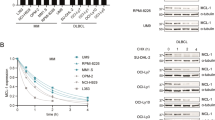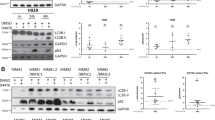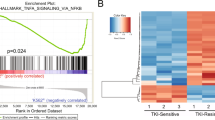Abstract
Regulation of cell survival is a key part of the pathogenesis of multiple myeloma (MM). Jun N-terminal kinase (JNK) signaling has been implicated in MM pathogenesis, but its function is unclear. To elucidate the role of JNK in MM, we evaluated the specific functions of the two major JNK proteins, JNK1 and JNK2. We show here that JNK2 is constitutively activated in a panel of MM cell lines and primary tumors. Using loss-of-function studies, we demonstrate that JNK2 is required for the survival of myeloma cells and constitutively suppresses JNK1-mediated apoptosis by affecting expression of poly(ADP-ribose) polymerase (PARP)14, a key regulator of B-cell survival. Strikingly, we found that PARP14 is highly expressed in myeloma plasma cells and associated with disease progression and poor survival. Overexpression of PARP14 completely rescued myeloma cells from apoptosis induced by JNK2 knockdown, indicating that PARP14 is critically involved in JNK2-dependent survival. Mechanistically, PARP14 was found to promote the survival of myeloma cells by binding and inhibiting JNK1. Moreover, inhibition of PARP14 enhances the sensitization of MM cells to anti-myeloma agents. Our findings reveal a novel regulatory pathway in myeloma cells through which JNK2 signals cell survival via PARP14, and identify PARP14 as a potential therapeutic target in myeloma.
This is a preview of subscription content, access via your institution
Access options
Subscribe to this journal
Receive 50 print issues and online access
$259.00 per year
only $5.18 per issue
Buy this article
- Purchase on Springer Link
- Instant access to full article PDF
Prices may be subject to local taxes which are calculated during checkout







Similar content being viewed by others
References
Anderson KC, Carrasco RD . Pathogenesis of myeloma. Annu Rev Pathol 2011; 6: 249–274.
Raab MS, Podar K, Breitkreutz I, Richardson PG, Anderson KC . Multiple myeloma. Lancet 2009; 374: 324–339.
Rajkumar SV . Treatment of multiple myeloma. Nat Rev Clin Oncol 2011; 8: 479–491.
Hallek M, Bergsagel PL, Anderson KC . Multiple myeloma: increasing evidence for a multistep transformation process. Blood 1998; 91: 3–21.
Witzig TE, Timm M, Larson D, Therneau T, Greipp PR . Measurement of apoptosis and proliferation of bone marrow plasma cells in patients with plasma cell proliferative disorders. Br J Haematol 1999; 104: 131–137.
Platanias LC . Map kinase signaling pathways and hematologic malignancies. Blood 2003; 101: 4667–4679.
Geest CR, Coffer PJ . MAPK signaling pathways in the regulation of hematopoiesis. J Leukoc Biol 2009; 86: 237–250.
Raman M, Chen W, Cobb MH . Differential regulation and properties of MAPKs. Oncogene 2007; 26: 3100–3112.
Kim K, Kong SY, Fulciniti M, Li X, Song W, Nahar S et al. Blockade of the MEK/ERK signalling cascade by AS703026, a novel selective MEK1/2 inhibitor, induces pleiotropic anti-myeloma activity in vitro and in vivo. Br J Haematol 2010; 149: 537–549.
Hideshima T, Akiyama M, Hayashi T, Richardson P, Schlossman R, Chauhan D et al. Targeting p38 MAPK inhibits multiple myeloma cell growth in the bone marrow milieu. Blood 2003; 101: 703–705.
Bogoyevitch MA, Kobe B . Uses for JNK: the many and varied substrates of the c-Jun N-terminal kinases. Microbiol Mol Biol Rev 2006; 70: 1061–1095.
Wagner EF, Nebreda AR . Signal integration by JNK and p38 MAPK pathways in cancer development. Nat Rev Cancer 2009; 9: 537–549.
Sabapathy K, Jochum W, Hochedlinger K, Chang L, Karin M, Wagner EF . Defective neural tube morphogenesis and altered apoptosis in the absence of both JNK1 and JNK2. Mech Dev 1999; 89: 115–124.
Anbalagan M, Sabapathy K . JNK1 and JNK2 play redundant functions in Myc-induced B cell lymphoma formation. Int J Cancer 2012; 130: 1967–1969.
Kennedy NJ, Davis RJ . Role of JNK in tumor development. Cell Cycle 2003; 2: 199–201.
Nitta RT, Del Vecchio CA, Chu AH, Mitra SS, Godwin AK, Wong AJ . The role of the c-Jun N-terminal kinase 2-α-isoform in non-small cell lung carcinoma tumorigenesis. Oncogene 2011; 30: 234–244.
Bost F, McKay R, Bost M, Potapova O, Dean NM, Mercola D . The Jun kinase 2 isoform is preferentially required for epidermal growth factor-induced transformation of human A549 lung carcinoma cells. Mol Cell Biol 1999; 19: 1938–1949.
Cui J, Han SY, Wang C, Su W, Harshyne L, Holgado-Madruga M et al. c-Jun NH(2)-terminal kinase 2alpha2 promotes the tumorigenicity of human glioblastoma cells. Cancer Res 2006; 66: 10024–10031.
Yoon C-H, Kim M-J, Kim R-K, Lim E-J, Choi K-S, An S et al. c-Jun N-terminal kinase has a pivotal role in the maintenance of self-renewal and tumorigenicity in glioma stem-like cells. Oncogene 2012; 31: 4655–4666.
Yang YM, Bost F, Charbono W, Dean N, McKay R, Rhim JS et al. c-Jun NH(2)-terminal kinase mediates proliferation and tumor growth of human prostate carcinoma. Clin Cancer Res 2003; 9: 391–401.
Ke H, Harris R, Coloff JL, Jin JY, Leshin B, Miliani de Marval P et al. The c-Jun NH2-terminal kinase 2 plays a dominant role in human epidermal neoplasia. Cancer Res 2010; 70: 3080–3088.
Chen N, Nomura M, She QB, Ma WY, Bode AM, Wang L et al. Suppression of skin tumorigenesis in c-Jun NH(2)-terminal kinase-2-deficient mice. Cancer Res 2001; 61: 3908–3912.
Hui L, Zatloukal K, Scheuch H, Stepniak E, Wagner EF . Proliferation of human HCC cells and chemically induced mouse liver cancers requires JNK1-dependent p21 downregulation. J Clin Invest 2008; 118: 3943–3953.
Hideshima T, Hayashi T, Chauhan D, Akiyama M, Richardson P, Anderson K . Biologic sequelae of c-Jun NH(2)-terminal kinase (JNK) activation in multiple myeloma cell lines. Oncogene 2003; 22: 8797–8801.
Hideshima T, Mitsiades C, Akiyama M, Hayashi T, Chauhan D, Richardson P et al. Molecular mechanisms mediating antimyeloma activity of proteasome inhibitor PS-341. Blood 2003; 101: 1530–1534.
Kajiguchi T, Yamamoto K, Iida S, Ueda R, Emi N, Naoe T . Sustained activation of c-jun-N-terminal kinase plays a critical role in arsenic trioxide-induced cell apoptosis in multiple myeloma cell lines. Cancer Sci 2006; 97: 540–545.
Chauhan D, Li G, Hideshima T, Podar K, Mitsiades C, Mitsiades N et al. JNK-dependent release of mitochondrial protein, Smac, during apoptosis in multiple myeloma (MM) cells. J Biol Chem 2003; 278: 17593–17596.
Bogoyevitch MA, Ngoei KR, Zhao TT, Yeap YY, Ng DC . c-Jun N-terminal kinase (JNK) signaling: recent advances and challenges. Biochim Biophys Acta 2010; 1804: 463–475.
Goenka S, Boothby M . Selective potentiation of Stat-dependent gene expression by collaborator of Stat6 (CoaSt6), a transcriptional cofactor. Proc Natl Acad Sci USA 2006; 103: 4210–4215.
Cho SH, Goenka S, Henttinen T, Gudapati P, Reinikainen A, Eischen CM et al. PARP-14, a member of the B aggressive lymphoma family, transduces survival signals in primary B cells. Blood 2009; 113: 2416–2425.
Cho SH, Ahn AK, Bhargava P, Lee CH, Eischen CM, McGuinness O et al. Glycolytic rate and lymphomagenesis depend on PARP14, an ADP ribosyltransferase of the B aggressive lymphoma (BAL) family. Proc Natl Acad Sci USA 2011; 108: 15972–15977.
Spanoudakis E, Hu M, Naresh K, Terpos E, Melo V, Reid A et al. Regulation of multiple myeloma survival and progression by CD1d. Blood 2009; 113: 2498–2507.
Pham CG, Bubici C, Zazzeroni F, Knabb JR, Papa S, Kuntzen C et al. Upregulation of Twist-1 by NF-kappaB blocks cytotoxicity induced by chemotherapeutic drugs. Mol Cell Biol 2007; 27: 3920–3935.
Wiznerowicz M, Trono D . Conditional suppression of cellular genes: lentivirus vector-mediated drug-inducible RNA interference. J Virol 2003; 77: 8957–8961.
Gururajan M, Chui R, Karuppannan AK, Ke J, Jennings CD, Bondada S . c-Jun N-terminal kinase (JNK) is required for survival and proliferation of B-lymphoma cells. Blood 2005; 106: 1382–1391.
Liu J, Minemoto Y, Lin A . c-Jun N-terminal protein kinase 1 (JNK1), but not JNK2, is essential for tumor necrosis factor alpha-induced c-Jun kinase activation and apoptosis. Mol Cell Biol 2004; 24: 10844–10856.
Ahmed SU, Milner J . Basal cancer cell survival involves JNK2 suppression of a novel JNK1/c-Jun/Bcl-3 apoptotic network. PLoS One 2009; 4: e7305.
Schreiber V, Dantzer F, Ame JC, de Murcia G . Poly(ADP-ribose): novel functions for an old molecule. Nat Rev Mol Cell Biol 2006; 7: 517–528.
Zhan F, Huang Y, Colla S, Stewart JP, Hanamura I, Gupta S et al. The molecular classification of multiple myeloma. Blood 2006; 108: 2020–2028.
Zhan F, Barlogie B, Arzoumanian V, Huang Y, Williams DR, Hollmig K et al. Gene-expression signature of benign monoclonal gammopathy evident in multiple myeloma is linked to good prognosis. Blood 2007; 109: 1692–1700.
Brune V, Tiacci E, Pfeil I, Döring C, Eckerle S, van Noesel CJ et al. Origin and pathogenesis of nodular lymphocyte-predominant Hodgkin lymphoma as revealed by global gene expression analysis. J Exp Med 2008; 205: 2251–2268.
Gangopadhyay NN, Luketich JD, Opest A, Visus C, Meyer EM, Landreneau R et al. Inhibition of poly(ADP-ribose) polymerase (PARP) induces apoptosis in lung cancer cell lines. Cancer Invest 2011; 29: 608–616.
Bardwell AJ, Frankson E, Bardwell L . Selectivity of docking sites in MAPK kinases. J Biol Chem 2009; 284: 13165–13173.
Cui J, Holgado-Madruga M, Su W, Tsuiki H, Wedegaertner P, Wong AJ . Identification of a specific domain responsible for JNK2alpha2 autophosphorylation. J Biol Chem 2005; 280: 9913–9920.
Ke H, Harris R, Coloff JL, Jin JY, Leshin B, Miliani de Marval P et al. The c-Jun NH2-terminal kinase 2 plays a dominant role in human epidermal neoplasia. Cancer Res 2010; 70: 3080–3088.
Ford J, Ahmed S, Allison S, Jiang M, Milner J . JNK2-dependent regulation of SIRT1 protein stability. Cell Cycle 2008; 7: 3091–3097.
Pruitt K, Zinn RL, Ohm JE, McGarvey KM, Kang SH, Watkins DN et al. Inhibition of SIRT1 reactivates silenced cancer genes without loss of promoter DNA hypermethylation. PLoS Genet 2006; 2: e40.
Goenka S, Cho SH, Boothby M . Collaborator of Stat6 (CoaSt6)-associated poly(ADP-ribose) polymerase activity modulates Stat6-dependent gene transcription. J Biol Chem 2007; 282: 18732–18739.
Aravind L . The WWE domain: a common interaction module in protein ubiquitination and ADP ribosylation. Trends Biochem Sci 2001; 26: 273–275.
Yanagawa T, Funasaka T, Tsutsumi S, Hu H, Watanabe H, Raz A . Regulation of phosphoglucose isomerase/autocrine motility factor activities by the poly(ADP-ribose) polymerase family-14. Cancer Res 2007; 67: 8682–8689.
Zazzeroni F, Papa S, Algeciras-Schimnich A, Alvarez K, Melis T, Bubici C et al. Gadd45beta mediates the protective effects of CD40 costimulation against Fas-induced apoptosis. Blood 2003; 102: 3270–3279.
Papa S, Zazzeroni F, Bubici C, Jayawardena S, Alvarez K, Matsuda S et al. Gadd45beta mediates the NF-kappaB suppression of JNK signalling by targeting MKK7/JNKK2. Nat Cell Biol 2004; 6: 146–153.
Blonska M, Pappu BP, Matsumoto R, Li H, Su B, Wang D et al. The CARMA1-Bcl10 signaling complex selectively regulates JNK2 kinase in the T cell receptor-signaling pathway. Immunity 2007; 26: 55–66.
Naresh KN, Lampert I, Hasserjian R, Lykidis D, Elderfield K, Horncastle D et al. Optimal processing of bone marrow trephine biopsy: the Hammersmith Protocol. J Clin Pathol 2006; 59: 903–911.
Acknowledgements
We are grateful to S Chokshi, R Williams and J Dyson for critical comments on the manuscript. We also thank D Trono (Ecole Polytechnique Fédérale de Lausanne, Switzerland) for the pWPI lentiviral vector and M Johns (Imperial College) for the human PARP14 cDNA; H Cooksley, A Riva (Institute of Hepatology), and PM Choy, MH Lam and V Patel (MSc students) for technical support. GF receives funding from NIH grants R01 CA084040 and R01 CA098583 and Cancer Research UK grant C26587/A8839. DOH receives professorial support from the British Heart Foundation. This study was primarily supported by a research grant from Kay Kendall Leukemia Fund (KKL443) to CB, and in part by grants from Italian Association for Cancer Research (Start-up 8557) and the Foundation for Liver Research to S.P.
Author information
Authors and Affiliations
Corresponding authors
Ethics declarations
Competing interests
The authors declare no conflict of interest.
Additional information
Supplementary Information accompanies the paper on the Oncogene website
Supplementary information
Rights and permissions
About this article
Cite this article
Barbarulo, A., Iansante, V., Chaidos, A. et al. Poly(ADP-ribose) polymerase family member 14 (PARP14) is a novel effector of the JNK2-dependent pro-survival signal in multiple myeloma. Oncogene 32, 4231–4242 (2013). https://doi.org/10.1038/onc.2012.448
Received:
Revised:
Accepted:
Published:
Issue Date:
DOI: https://doi.org/10.1038/onc.2012.448
Keywords
This article is cited by
-
PARP14 regulates cyclin D1 expression to promote cell-cycle progression
Oncogene (2021)
-
Interplay between ADP-ribosyltransferases and essential cell signaling pathways controls cellular responses
Cell Discovery (2021)
-
A short review on cross-link between pyruvate kinase (PKM2) and Glioblastoma Multiforme
Metabolic Brain Disease (2021)
-
The ERK and JNK pathways in the regulation of metabolic reprogramming
Oncogene (2019)
-
Stromal expression of JNK1 and VDR is associated with the prognosis of esophageal squamous cell carcinoma
Clinical and Translational Oncology (2018)



